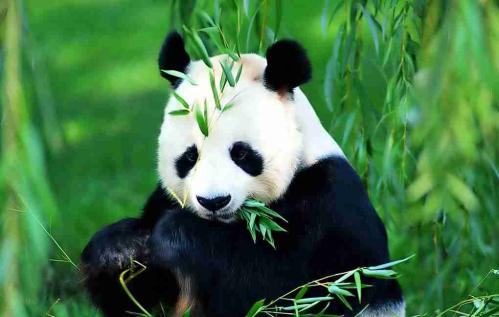导读:你知道为什么熊猫明明是食肉动物,可是却爱吃竹子吗?中国科学家从遗传学研究上告诉你原因!

Chinese researchers said Monday they have uncovered the genetic basis of why giant pandas and red pandas have evolved independently to have shared features such as a bamboo-based diet and false thumb.
本周一中国研究人员表示说他们已经发现了大熊猫和红熊猫的遗传基础,可以解释为什么这两种动物独立进化,但是却又具备喜食竹子和假拇指等共同特点。
Despite being classified as carnivores, both giant pandas and red pandas, which separately evolved from meat-eating ancestors and diverged from each other more than 40 million years ago, subsist almost entirely on bamboo -- a phenomenon termed convergent evolution, where similar traits arise in two unrelated or distantly related species.
大熊猫和红熊猫都是分别从食肉祖先进化而来,并且已经分开超过4000万年。尽管这两种动物都被归类为食肉动物,但是它们却几乎完全依赖竹子生存——这种现象被称为趋同进化,相似的性状会在出现在两个无关、或者关系较远的物种身上。
Additionally, both species possess a false thumb, which enables the animals to adroitly grasp bamboo.
此外,这两个物种都具有假拇指,这可以使它们熟练地抓住竹子。
To uncover the genetic basis of such convergence, Fuwen Wei and colleagues from the Institute of Zoology, part of the Chinese Academy of Sciences, sequenced the genome of a wild male red panda and compared it with the reassembled genome of the giant panda. Their findings were published in the recent issue of U.S. journal Proceedings of the National Academy of Sciences.
为揭开这种趋同现象的遗传基础,傅文伟(音)和他中科院动物研究所的同事们对野生雄性红熊猫的基因组进行了测序,并和熊猫重新排列过后的基因组进行对比。他们的发现被刊载在美国杂志《美国国家科学院学报》最新一期上。
The results confirmed that giant pandas belong to the family Ursidae together with polar bears, whereas red pandas belong to the superfamily Musteloidea together with ferrets and that the two species separated 47.5 million years ago, slightly earlier than previous molecular-based estimate of 43 million years ago.
结果证实大熊猫和北极熊一样属于熊科(Ursidae),而红熊猫则和雪貂一样属于鼬科(Musteloidea)大家族,这两个物种在大约4750万年前分离,略早于先前根据分子估计的4300万年。
Genome analysis revealed signs of adaptive convergence in 70 genes, including two genes, known as DYNC2H1 and PCNT, that are involved in false thumb development.
基因组分析显示70个基因具有自适应收敛的迹象,包括有关长出假拇指的两个基因DYNC2H1和PCNT。
Further, enzymes involved in dietary protein digestion and amino acid utilization as well as proteins involved in vitamin metabolism and absorption showed signs of adaptive convergence, suggesting that these genes may have similarly evolved to support and supplement a bamboo-based diet.
此外,涉及到膳食蛋白质消化和氨基酸利用的酶、以及维生素代谢和吸收的蛋白质也显示出了自适应收敛的迹象,这表明这些基因可能已经相识地进化到可以支持和补充这两种动物以竹子为基础的食谱。
Giant and red panda genomes also share 10 pseudogenes, or "false" genes, which look like real genes but have no apparent function.
大熊猫和红熊猫的基因组里都有10个假基因,这些基因看起来跟真的一样,但是却没有明显的功能。
Notably, the TAS1R1 gene, which enables carnivores to taste meat’s umami flavor, has been pseudogenized in both pandas, reflecting the animals’ shift from carnivory to omnivory and, ultimately, herbivory.
值得注意的是,两种胖达体内的TAS1R1基因(这种基因使得肉食动物可以尝到肉的鲜味)都已经变成了假基因,这反映这两种动物从食肉动物变成了杂食性动物,并最终变成食草动物。
"Our findings provide rich insights into genetic convergence mechanisms underlying phenotypic convergence and adaptation to a specialized bamboo diet in both pandas," the researchers wrote in their paper.
研究人员们在他们的论文中写道:“我们的发现为两种胖达表型趋同和喜食竹子现象之下的遗传趋同机制提供了丰富的洞察。”